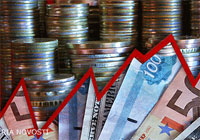Stagflation: A double anomaly for Russia

(Moscow News – themoscownews.com – Nathan Gray – January 23, 2014) As analysts air their prognoses for the Russian economy with the start of a new year, one word is circulating among officials and financial experts: stagflation.
After 2013’s slowdown in growth – a projected 1.3 percent, according to the World Bank in December, downgraded from an earlier projection of 1.8 percent – forecasts for this year are slightly higher, though still somber.
“The world is going to show a growth rate of more than 3.5 percent, but in the best case, we will have 2.5 percent,” Economic Development Minister Alexei Ulyukayev said at last week’s Gaidar Forum in Moscow, RIA Novosti reported. “This will be for 2013, 2014, 2015 and, possibly, the following years. This is a challenge we must answer.”
Similar to the lower figures for economic growth, inflation in 2013 finished higher than expected, with a forecast year-end rate of 6.5 percent.
The combination of the growth and inflation figures have led to conclusions that Russia is in stagflation, but, following on from the anomaly of the concept itself – rising prices amid slow growth – Russia’s case is doubly anomalous. Slow growth usually brings with it high unemployment, but in Russia, the labor market has remained tight, with a figure of 5.4 percent in November.
“It’s quite unusual in Russia, where you have a very tight labor market, a relatively low unemployment rate, and you still have this slowing growth,” Chris Weafer, founding partner at Macro Advisory, told The Moscow News.
One of the reasons for the double anomaly, Weafer said, is the distortion in economic activity, which concentrates on extractive industries and the state sector, where investment has been declining. Meanwhile, sectors such as retail, light manufacturing and consumer goods, which collectively account for the low unemployment figures, have been growing more rapidly.
The dominance of state companies is compounded by their effect on wages, pushing public-sector salaries above inflation level and forcing private employers to keep up in order to retain workers.
“The state casts a long shadow over all of the economy,” Weafer said. “On the one hand, it distorts the numbers, it shows a slowing economy where in actuality parts of the economy are growing very fast, and then secondly, the fact that they’re continuously boosting salaries and pushing up wages is having a negative cost impact across the broader economy.”
Officials disagree over whether Russia is in a state of stagflation. Both Ulyukayev and Central Bank first deputy chairman Ksenia Yudayeva say it is, but Ulyukayev’s deputy, Andrei Klepach, feels that only a threat remains that could take shape if growth continues to slow.
State policy needs to balance, however, between aiming at inflation and providing support for growth. For Timur Nigmatullin, an analyst at Investcafe, inflation-targeting is a long-term policy that will support more sustainable investment, while a decline in growth is “the price we need to pay” for lower inflation and longer-term development.
“As a result of the inflow of [long-term investment], there will be the possibility to develop the innovative sectors of the economy, and it is assumed that they will become the driver of growth,” Nigmatullin told The Moscow News. “Their anticipated growth will allow a lower dependence on prices of raw materials.”
An additional obstacle to the growth of these “innovative sectors,” however, remains the cost of borrowing, a legacy of the tight monetary policy exercised by the Central Bank and the Finance Ministry.
“You had this contradictory activity by the Finance [Ministry] and the Central Bank last year, which kept borrowing costs high,” Macro Advisory’s Weafer said. “They’ve said that they’re going to change and they’re much more aware of it, so we should see much looser monetary conditions coming into the market quite soon, which should, in theory, result in lower borrowing costs for businesses and retailers at the bank.”
